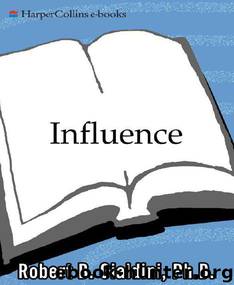Influence by Robert B. Cialdini

Author:Robert B. Cialdini [Cialdini, Robert B.]
Language: eng
Format: mobi, epub
Published: 0101-01-01T00:00:00+00:00
potency of the scarcity principle is
that, by following it, we are usually
and efficiently right.106
FIGURE 7-3
Don’t Wait!
Last chance to read this now
before you turn the page
( ROBERT B. CIALDINI)
In addition, there is a unique,
secondary source of power within
the scarcity principle: As
opportunities become less
available, we lose freedoms; and
we hate to lose the freedoms we
already have. This desire to
preserve our established
prerogatives is the centerpiece of
psychological reactance theory,
developed by psychologist Jack
Brehm to explain the human
response to diminishing personal
control. According to the theory,
whenever free choice is limited or
threatened, the need to retain our
freedoms makes us desire them (as
well as the goods and services
associated with them) significantly
more than previously. So when
increasing scarcity—or anything
else—interferes with our prior
access to some item, we will react
against the interference by wanting
and trying to possess the item more
than before. 107
As simple as the kernel of the
theory seems, its shoots and roots
curl extensively through much of the
social environment. From the
garden of young love to the jungle
of armed revolution to the fruits of
the marketplace, impressive
amounts of our behavior can be
explained by examining for the
tendrils of psychological reactance.
Before beginning such an
examination, though, it would be
helpful to know when people first
show the desire to fight against
restrictions of their freedoms.
Child psychologists have traced
the tendency back to the start of the
third year of life—a year
independently identified as a
problem by parents and widely
known to them as “the terrible
twos.” Most parents can attest to the
development of a decidedly more
contrary style in their children
around this period. Two-year-olds
seem masters of the art of resistance
to outside, especially parental,
pressure: Tell them one thing, they
do the opposite; give them one toy,
they want another; pick them up
against their will, they wriggle and
squirm to be put down; put them
down against their will, they claw
and struggle to be carried.
One Virginia-based study nicely
captured the terrible twos style
among boys who averaged twenty-
four months in age. The boys
accompanied their mothers into a
room containing two equally
attractive toys. The toys were
always arranged so that one stood
next to a transparent Plexiglas
barrier and the other stood behind
the barrier. For some of the boys,
the Plexiglas sheet was only a foot
tall—forming no real barrier to the
toy behind, since the boys could
easily reach over the top. For the
other boys, however, the Plexiglas
was two feet tall, effectively
blocking the boys’ access to one toy
unless they went around the barrier.
The researchers wanted to see how
quickly the toddlers would make
contact with the toys under these
conditions. Their findings were
clear. When the barrier was too
small to restrict access to the toy
behind it, the boys showed no
special preference for either of the
toys; on the average, the toy next to
the barrier was touched just as
quickly as the one behind. But when
the barrier was big enough to be a
true obstacle, the boys went directly
to the obstructed toy, making contact
with it three times faster than with
the unobstructed toy. In all, the boys
in this study demonstrated the
classic terrible twos’ response to a
limitation of their freedom: outright
defiance. 108
Why should psychological
reactance emerge at the age of two?
Perhaps the answer has to do with a
crucial change that most children go
through around this time. It is then
that they first come to a full
recognition of themselves as
individuals.
Download
This site does not store any files on its server. We only index and link to content provided by other sites. Please contact the content providers to delete copyright contents if any and email us, we'll remove relevant links or contents immediately.
Goodbye, Things by Fumio Sasaki(8293)
The Road Less Traveled by M. Scott Peck(7279)
Daring Greatly by Brene Brown(6227)
Big Magic: Creative Living Beyond Fear by Elizabeth Gilbert(5353)
Grit by Angela Duckworth(5300)
Discipline Equals Freedom by Jocko Willink(5157)
Ego Is the Enemy by Ryan Holiday(4958)
The Wisdom of Sundays by Oprah Winfrey(4950)
The Laws of Human Nature by Robert Greene(4774)
You Are a Badass at Making Money by Jen Sincero(4657)
Influence: The Psychology of Persuasion by Robert B. Cialdini(4601)
The Miracle Morning by Hal Elrod(4422)
Rising Strong by Brene Brown(4192)
Reflections Of A Man by Mr. Amari Soul(4129)
A Simplified Life by Emily Ley(3969)
The Power of Positive Thinking by Norman Vincent Peale(3861)
Seriously... I'm Kidding by Ellen DeGeneres(3412)
How to Win Friends and Influence People in the Digital Age by Dale Carnegie & Associates(3366)
Delivering Happiness by Tony Hsieh(3283)
